Marine Life Society of
South Australia Inc.
Newsletter
November 2005 No. 327
“understanding,
enjoying & caring for our oceans”
Next Meeting
This will be the November Meeting and will be held at the Conservation
Centre, 120 Wakefield Street, Adelaide on Wednesday 16th November
commencing at 7.30pm.
Our speaker will be John Emmett who will be discussing MPA’s.
Contents
Queenscliff Marine Discovery Centre (Philip Hall)
Greg Rouse’s Marine Worm
(& Feather Star) Research Part 1 (Steve Reynolds)
This is the final newsletter for 2005 and I would
like to take this opportunity to wish everyone a very Happy Christmas and a
really great New Year. I look forward to seeing you all at the first meeting in
2006 on the 18th January.
There will of course be a Journal sent out to
members in December. At the time of writing this I am not certain if a PDF
version will be possible due to the large graphic content which means the size
might be too great to send. It will be on our website in colour of course.
Philip Hall
REMINDER
Articles for YOUR Newsletter are always
required. The more people who write articles then the wider the topic spread.
Please do not leave it up to just a few. Articles of any length are welcome.
This Newsletter
The hardcopy of the Newsletter is in black and white as usual. If members prefer a colour PDF version then please email me.
Queenscliff Marine
Discovery Centre
by Philip Hall
During our short
September holiday in Melbourne to see the Dutch Masters display at the Art
Gallery we went via Queenscliff so we could visit the Marine Discovery Centre
there.
It used to be
housed in a building near the Sorrento ferry terminal. It was rather run down
when we visited it some years ago so when we heard it had been recently rebuilt
we decided to pay it a visit. It is now housed in an award winning building a
couple of kilometres before the town itself.
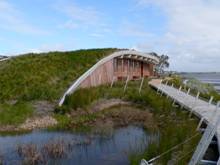
As you can see
from the picture much care has been taken with the design from environmental
and aesthetic points of view.
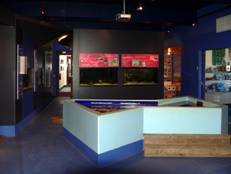
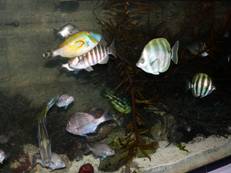
The Centre opens
at 10.00am so we were the first there. The friendly staff member warned us that
a large group of very young children was expected so we quickly entered the
main area. We stared in amazement at the large number of aquaria in view, of
different sizes and beautifully clean and well lit built into the walls.
The tanks were
all full of creatures and were often dedicated to just one species. For example
the seajellies had their own tank as did the octopus
and the seahorses. Others had to share and many familiar creatures and fish can
be studied.
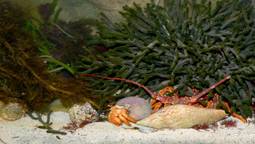
One tank
contained the Pacific Seastar; I have never seen such a large seastar before.
They were huge.
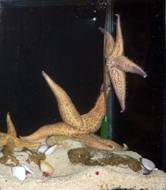
The only
criticism we had was the large touch pool in the centre of the floor. (You must
know my views on the handling of marine creatures). In it were mainly seastars
and urchins. Again the water was crystal clear and beautifully lit. Small
platforms around the outside were arranged for smaller children to stand on.
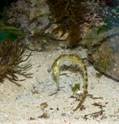
A separate
teaching room was equipped with TV and video, comfortable seats and carpet and
plenty of items to inspect around the walls. One wall had a beautiful glass
mural built into it. (Below)

Other areas
included one with so many items we could have spent hours there checking them
all out. The way they were displayed was excellent. They were in small wooden
boxes, some were open and others with more delicate items had plastic fronts.
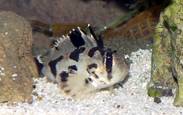
One wall faced
out onto Port Philip Bay and long slit windows low down would enable children
(or crouching adults) to watch the many birds on the water or in the reed beds.
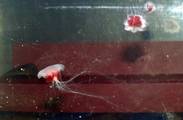
The Centre is
only a small part of the complex. Other organisations occupy the rest and I
assume they are all marine based.
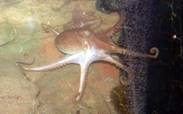
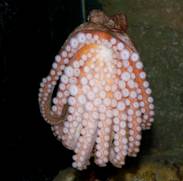
We left in time
to catch the 11.00am ferry to Sorrento very impressed with the quality of the
Centre and vowing to return in a few years time to see how it progresses.
All in all well worth a visit the next time you
are in the area. By the way, it is only open on weekdays.
Greg Rouse’s Marine Worm (& Feather Star)
Research
by Steve Reynolds
I first heard
about the work of Dr Greg Rouse from the SA Museum when I read The Advertiser
dated 22nd March 2002. There was a report about a student from the
University of Adelaide studying feather stars. The student was Lauren Johnston and
her study was said to be “being overseen by museum research scientist and
marine expert Greg Rouse”. (More on this later.)
On 6th
May 2002 The Advertiser reported that Greg had an ongoing mystery about a
strange, glowing blue worm living in the mud at St Kilda in SA. Anglers had
long told stories about the strange, mysterious worm which could grow as long
as 1m.
Greg had not
long arrived in SA when he found a jar of the strange worms in the SA Museum
archives, together with a manuscript-length analysis on the worm. This had been
written by the late Dr Shane Parker, a former museum researcher. He wrote it
about 1992, just before he died. The jar of specimens had been lost during a
‘reshuffle’ at the museum. Once rediscovered by Greg, it became one of his
major projects. The blue-glowing worm was a eunicid,
a species of worm from the family Eunicidae. Greg
plans to name it in honour of Dr Parker.
In that May
issue of The Advertiser, Greg was calling for anyone finding unusual sea
creatures to let him know about it immediately. The article also reported that
Greg had co-authored a book about polychaete worms
with Fredrik Pleijel, the French scientist, in 2001.
That book would be “Polychaetes” by GW Rouse & F Pleijel, Oxford University Press, London, 2001. Greg has
still to find a live specimen of the blue worm.
Polychaetes are bristle worms which form part of the Phylum Annelida that also includes leeches and earthworms.
Greg was in the
news again in October 2003. The Advertiser dated 4th October
reported more about Greg’s work including how he would take pictures of marine
creatures through a stereo-microscope. The pictures were usually breathtaking
and he entered one of them in the Nikon 2003 Small World Photomicrography
Competition.
His photo was of
a polychaete worm, Myrianida
pachycera (formerly Autolytus
pachycerus) (Family Syllidae),
collected from Bondi in New South Wales. It can be
seen on the first (title) page of the web page at
http://tolweb.org/tree?group=Annelida&contgroup=Bilateria
.
It is the first
of four species featured there.
(Syllids (species from the Family Syllidae)
are described in “Marine Invertebrates of Southern Australia – Part 1” (Marine
Inverts. 1) as being from “a diverse group of worms”. They are described in
detail on pages 241-2 of the book edited by SA Shepherd and IM Thomas.)
The special
microscope magnified the worm 60 times. The shot won him Second Prize out of
about1200 entries in the photo competition.
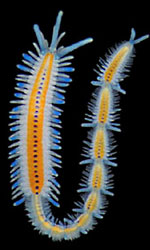
Autolytus pachycerus
Greg said that Myrianida pachycera
is fairly common and can be found on algae on inter-tidal rocks all around the
SA coast. “The worm is about a quarter of the length of a fingernail, people
are usually walking on these things,” he said.
It was reported
by The Advertiser at the time that the gallery of images entered in the photo
competition could be seen at www.nikon-smallworld.com
.
In 2004 the
Marine Life Society of SA invited Greg along to our April General Meeting to
give a presentation about marine worms and to help us with identification of
some of the worm slides in our Photographic Index of SA Marine Life. He agreed
to come along to talk to us.
Greg started his
presentation off by showing us a video of spawning cuttlefish at Whyalla. At
the end of the video he proceeded with his prepared talk on marine worms. He
discussed, for example, polychaete worms (Phylum Annelida). He said that polychaetes
used to be divided into two Orders – Errantia and Sedentaria. Polychaete worms were
arranged into these two groups according to whether they are ‘free-wandering’ (Errantia) or they are modified for a permanent life in
tubes or sand-burrows (Sedentaria).
(I later asked
Greg about this and he directed me to
http://tolweb.org/tree?group=Annelida&contgroup=Bilateria
which included comments about ‘Errantia’
and ‘Sedentaria’. I have kept a file copy of the web
page. More about this later.)
Greg’s talk in
was illustrated by the use of a digital projector. He went on to say that
(world-wide) there are more than 9,000 species of polychaete
worms.
(This is also
explained on the web page at
http://tolweb.org/tree?group=Annelida&contgroup=Bilateria
where it says “Around 9000 species of polychaetes
are currently recognized with several thousand more names in synonymy, and the
overall systematics of the group remains unstable.”)
Greg then told
us of two surveys that had been done under the Edithburgh jetty on SA’s Yorke
Peninsula. Myzostome worms and their crinoid (feather-stars) hosts were discussed, including
stalked crinoids (or sea lilies). He told us about the recent naming of two new
worm species – Myzostoma australe and Myzostoma
seymourcollegiorum.
(The naming of
these two Myzostoma worms was reported in our
February 2004 Newsletter (No.307) in the article titled “New Bluff Resident
Discovered”. Greg discovered Myzostoma australe, however, in the waters of the Nuyts
Archipelago near Ceduna during the Encounter 2002 Expedition to the Isles of St
Francis. It was Myzostoma seymourcollegiorum that he found in Encounter Bay,
Victor Harbor (at the Bluff) in 2003. More about this later.)
Greg told us
about the SA Museum’s marine photographic index which can be viewed at
http://129.127.105.50:591/index.html
(At the time of
writing, the site is undergoing rebuilding but it should be up again soon.) He
then went on to tell us about the discovery of two new species of worms found
living on the bones of a 9-10m long dead Gray Whale, Eschrichtius
robustus. (I later found some details about these
two new species of worms on the Internet. More details about this follow
shortly.)
At the end of
Greg’s presentation he was able to help us to identify some of the worm slides in
our Photo Index. This allowed us to tidy up the details of worms in our Photo
Index a little bit.
Now, here is my
version of some details that I found on the Internet about the discovery of the
two new species of worms found living on the bones of a dead Gray Whale: -
Researchers from
the Monterey Bay Aquarium and Research Institute were studying clam ecology
when they made the discovery. They found the first of the worms on 8th
February 2002. They were using a remotely operated submarine (called Tiburon,
after the Spanish for shark) which discovered the Gray Whale carcass at a depth
of 2,891m in the Monterey Canyon (Monterey Bay, California).
When they got
the whale rib bone to the surface, they immediately knew that they were dealing
with something totally different. At first, the researchers were at a loss to
determine what kind of creature they had found.
Further remotely
operated submarine dives were made to collect more specimens of worms from the
same Gray Whale carcass. A piece of vertebra and another rib were both
collected on 7th August 2002.
Two species of
worm were found on the whale carcass. These worms were quite strange in that
they had neither eyes or a stomach, and not even any mouth. The worms range in
size from 25 to 63mm long. They have colourful, feathery plumes that serve as
gills. They also have green ‘roots’ that work their way into the bones of dead
whales. Bacteria living in the worms digest the fats and oils in the whalebone.
The researchers named the worms, a new genus, Osedax,
which is Latin for ‘bone eating’.
Researcher Dr
Robert Vrijenhoek said “The worms provide insight
into the cycling of carbon that reaches the bottom of the ocean. A dead whale
delivers the equivalent of 2000 years of 'marine snow' drifting to the bottom
where carbon is fixed into organic molecules. Marine snow is made up of bits of
dead fish and other matter that settle to the floor of the sea, feeding many
creatures there. The worms turn whalebone fats into worm eggs and larvae that
are carried away from the carcass to produce new worms (or to be eaten and
dispersed by other animals). This discovery adds to the limited knowledge we
have about what happens to organic carbon on the bottom of the ocean”.
The researchers
were puzzled when all of the worms were found to be female. Greg Rouse took
some to his laboratory for study and discovered tiny male worms living inside
the tubes of females. There were up to100 or more males with each female.
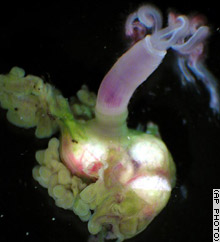
Photograph of one of the dissected Osedax worms (courtesy of Greg Rouse).
Bacteria are found in the green tissue and part of it has been torn,
exposing the white ovary.
The males still
contained bits of yolk, as if they had never developed past their larval stage,
but they also contained large amounts of sperm. The female worms, regardless of
size, were full of eggs.
Dr Vrijenhoek said that a whale carcass might last for decades
before it is fully consumed. The carcasses (‘whale fall’) tend to be found
along migration routes so that eggs dispersed from one whale-eating worm may
find another carcass nearby. He also said that the worms have no mouth, no
guts, no obvious segments like all worms are supposed
to have.
He said that
they look very much like little miniature versions of the strange worms
discovered living around hydrothermal vents in the oceans. These vents are
cracks in the ocean floor where very hot, mineral-rich water bubbles out from
the earth's crust. When the team extracted DNA from the new worms they
discovered that they were indeed related to the giant vent worms. The vent
worms have colonies of bacteria allowing them to live off sulphides
released from the vents, while the new worms have bacteria that digest fats
from bones.
The new
whalebone worms were divided into two species, Osedax
rubiplumus (for their red feathery gills) and O.
frankpressi (in honor of Frank Press). Frank is a
former President of the National Academy of Sciences who recently retired from
the board of the Monterey Bay Aquarium and Research Institute.
The researchers
concluded that the most recent common ancestor of the worms lived roughly 42m
years ago, about the same time whales themselves first evolved. This is all
explained in the paper “Osedax: Bone-eating
Marine Worms with Dwarf Males” by GW Rouse, SK Goffredi
& RC Vrijenhoek (under “Molecular-clock
calibration”). A copy of this paper is now being held in the MLSSA library.
Paratypes of both worm species are being held at both the Los
Angeles County Museum and the South Australian Museum. Additional material is
being held by the Monterey Bay Aquarium and Research Institute and as
histological slides at the SA Museum.
The Osedax worm research was funded by the David and
Lucille Packard Foundation, the National Science Foundation and the South
Australian Museum.
I asked Greg for
the full classification details for Osedax. He told me “Osedax
is in the group (more inclusive as you go along) Siboglinidae,
Sabellida, Canalipalpata, Annelida. The group Siboglinidae
used to be outside Annelida and was actually two
separate phyla, Pogonophora and Vestimentifera.
Some of my research showed that these two groups belonged together and inside Annelida. The name changed back to the first group name
which was Siboglinidae from 1914”.
Greg Rouse
participated in the “Encounter 2002” scientific expedition to the Isles of St
Francis in the Nuyts Archipelago in the Great Australian Bight (SA). He joined
some of our state’s leading botanists, marine biologists and archaeologists
including Dr Sue Murray-Jones and Dr Scoresby Shepherd (our Patron). The team
of 28 scientists went on board the RV Ngerin
for the 11-day expedition in February 2002.
My article “My
Continuing “Encounter” Experiences” in our 2004 MLSSA Journal reported that the
scientists “discovered eight new species of jellyfish. The results of the
expedition were released in the “South Australian Geographical Journal”, the
Journal of the Royal Society of South Australia. These (jellyfish) details were
reported in our February 2004 Newsletter (No.307)” (following the report about
Greg Rouse’s Myzostoma
worms).
Greg’s discovery
of Myzostoma australe
was also reported in the “South Australian Geographical Journal”, the Journal
of the Royal Society of South Australia. His description is reported in the
article “Encounter 2002 Expedition to the Isles of St Francis, South Australia:
Myzostoma australe
(Myzostomida), A new crinoid
associated worm from South Australia” in the “Transactions of the Royal Society
of S.Aust (2003).
In his opening
summary, Greg wrote that “No Myzostomida have been described from southern Australian waters. Most of
the described myzostome taxa
to date have been found in the warmer waters of the Indo-Pacific, where their crinoid hosts are most diverse. In this paper a new myzostome, Myzostoma australe n.sp., is described from the crinoid Ptilometra macronema
(Muller 1846) (Ptilometridae) taken from waters off
the Nuyts Archipelago, near Ceduna, South Australia”.
He went on to
say that “Myzostoma australe
is an ectocommensal on P. macronema
and somewhat resembles other Myzostoma informally
placed as the ‘ambiguum’ group by Grygier (1990). It differs from these in having a markedly
ellipsoidal body with an oval arrangement of parapodia
displaced forward, combined with the anterior two pairs and posterior pair of
cirri being longer than the rest. There has previously been no myzostome recorded from any species of Ptilometra”.
More details about Ptilometra macronema later.
Greg’s article
went on to describe Myzostomida in the Introduction
and the numbers of species recorded from around the Australian coast. Myzostome expert Mark J Grygier
indicated one species of myzostome from SA waters but
did not describe or name it. He had indicated in 1990 that his myzostome species (No.37) occurs on the comasterid
crinoid Cenolia trichoptera (Muller, 1846).
(This ends Part 1 - The second part will
be in the January Newsletter)